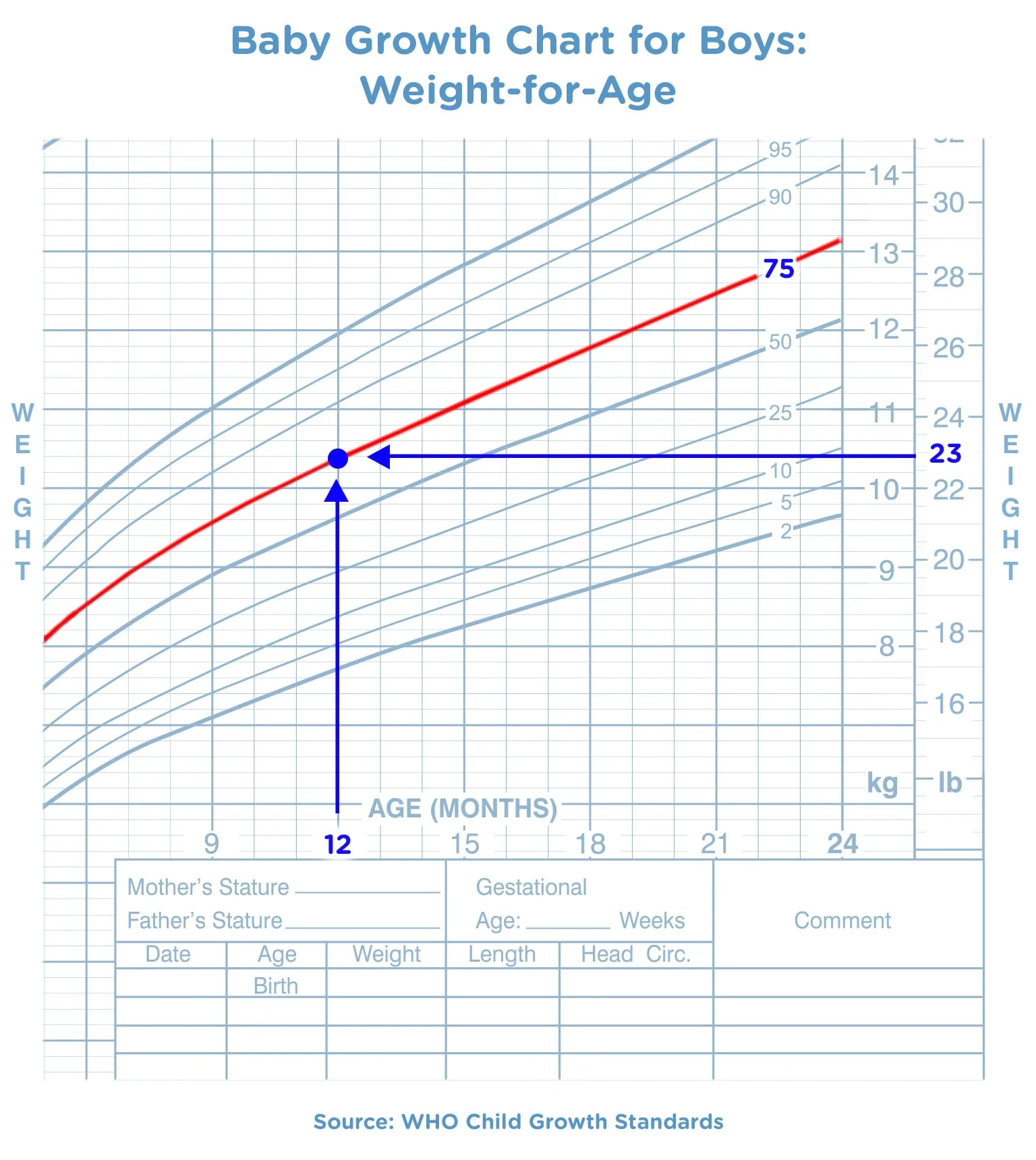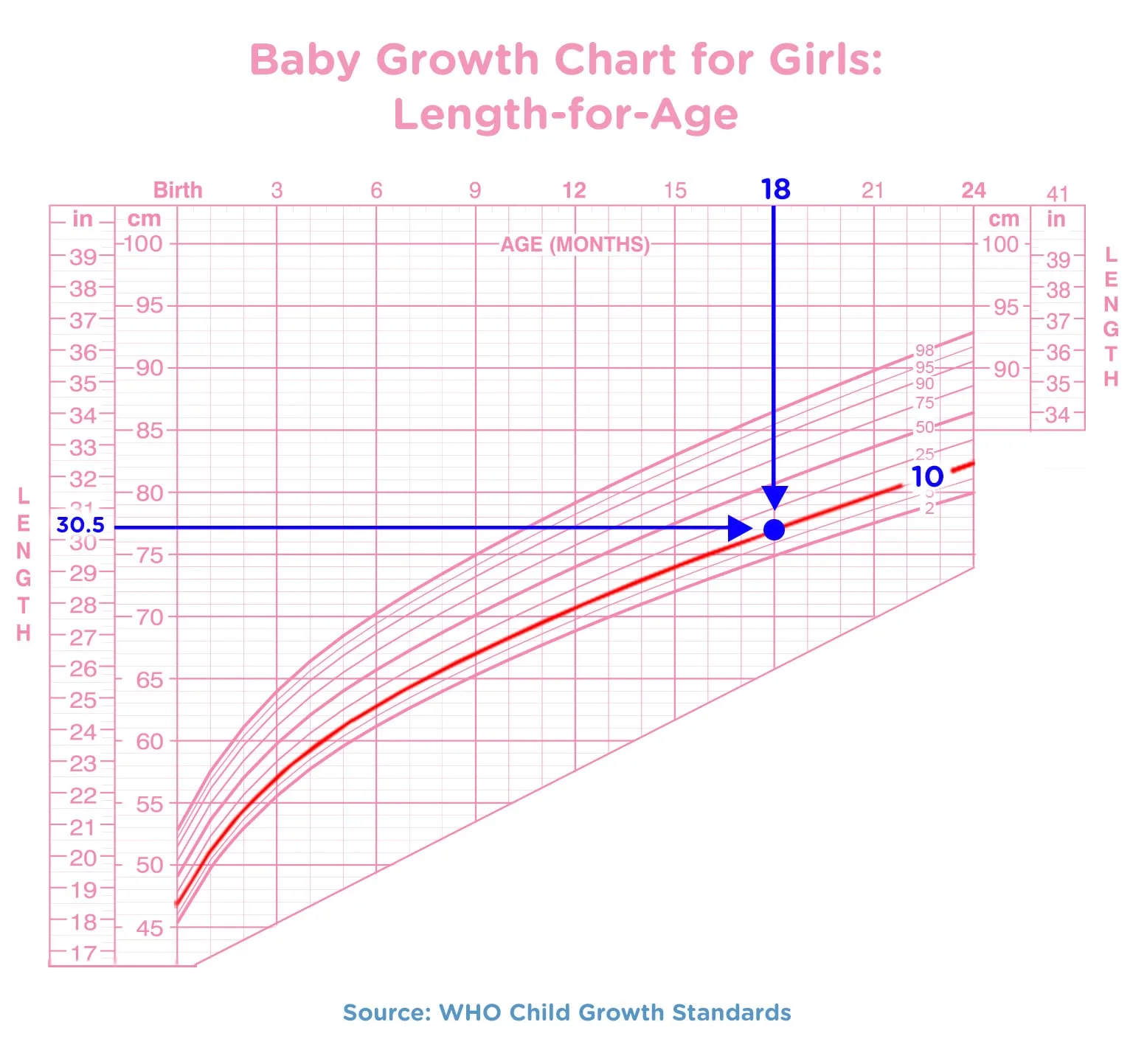
Baby Weight and Growth Charts for Boys and Girls
Children come in all shapes and sizes, and all infants grow at their own pace. Your child’s growth will be measured by his or her health visitor or doctor at regular intervals and plotted on baby growth charts to make sure he or she’s on track.
The charts might look daunting, but your doctor can help you understand this useful tool and what the results mean for your little one.
To make it easier, we'll show you how the baby growth and weight charts can be used to track your baby’s development, and how your health visitor or doctor interprets the results.
What Are Baby Growth Charts?
Your health visitor and doctor use baby growth and weight charts, known as ‘centile charts’, to track your baby’s physical development in the Personal Child Health Record (Red Book) that is usually given to you just before or after your baby is born.
The three things that may be measured are: weight, length and head circumference.
In the first two years, the baby weight chart is used to assess how your baby is growing month by month or year by year compared with other children of the same age and gender.
When your baby is 2 years old or older, the growth chart used to track his or her height can also be used to gain a rough estimate of how tall your child might be when he or she is fully grown.
After the age of 2, the length and weight charts can also be used by your doctor to calculate your child’s body mass index (BMI). This is considered to be a more reliable indicator of healthy body weight for children over the age of 24 months.
Different charts are used for boys and girls because baby boys are usually slightly heavier and longer than girls, and they follow different growth patterns.
For babies who were born prematurely (before 37 weeks of pregnancy), different charts are used until two weeks after the original due date. After that, the standard boy or girl growth charts are used, but a correction is applied based on how many weeks preterm your baby was born.
Downloadable Growth and Weight Charts for Baby Boys and Girls
The baby growth charts used in the United Kingdom are based on the WHO (World Health Organisation) growth standards combined with the average of baby weight and growth data gathered in the UK.
Keep in mind that accurately plotting and interpreting your child’s growth using these charts takes skill and practice, so for reliable results it should be done by your doctor or health visitor.
Download the baby growth charts here:
How Is Your Baby Measured?
This is how the three measurements are taken:
When Is Your Baby Measured?
Your baby may lose a little weight in the first few days after being born. This is normal, and he or she will usually be back to his or her original birthweight in about two weeks. In these first two weeks, your midwife or health visitor will be monitoring your baby’s weight to check that this is happening.
After the first two weeks your baby will usually be weighed
Length and other measurements aren’t always taken at the same time your baby is weighed, although your little one’s length and head circumference may be measured at some of his or her health and development reviews.
How to Read a Baby Weight or Growth Chart
Your doctor or health visitor will be able to help you understand your child’s growth charts, but here’s a quick guide to reading them. It’s important to use the boy charts if your baby is a boy and the girl charts if you have a girl.
How to Interpret the Results
The charts show the typical growth patterns for baby boys and girls. Most of the time healthy, well-nourished children will more-or-less follow the same growth pattern (the curved line) over time.
Keep in mind, however, that no two babies are the same. Even brothers and sisters can follow different growth patterns, and there is a very wide range of healthy results. Your doctor or health visitor is the best person to explain your child’s growth to you.
What Are the Centile Lines?
The baby growth cart shows which centile your child is in compared with others of the same age and gender. The centile lines are the curved lines you can see on the chart.
To find your little one’s centile for weight, for example, you would draw a straight line lengthways from your baby’s length (in the weight chart) and another downwards from his or her age. If these two lines meet at the centile line marked 70, this means your child is in the 70th centile for weight. In other words, 30 percent of babies the same age and gender are longer, and 70 percent are shorter.
The same method is used for plotting length and forehead circumference. Keep in mind that although for most babies the height and weight growth patterns are usually fairly close together, it’s not unusual for them to be on different centile lines in the weight and length charts.
Of course, a single measurement doesn't provide the complete picture. Your doctor and health visitor will assess several measurements over time to see the trend of how your child is growing in comparison to the average growth curve shown on the chart.
With this in mind, try not to get too focused on a single number. There’s a wide range of healthy weights and lengths, and your child’s growth can be influenced by lots of things such as genetics, environmental factors, activity levels and health problems.
How you feed your baby also makes a difference, as breastfed and formula-fed babies grow in slightly different patterns. For example, it’s perfectly natural for breastfed babies to put on weight more slowly than babies who get their nourishment from formula.
As your baby grows, the nappy size that fits him or her perfectly will change, too. Check out our nappy size and type guide to make sure that your baby’s nappy fits comfortably and has no leaks or blowouts.
What Happens if Your Baby’s Growth Pattern Changes?
A different growth pattern may not indicate a problem. Your child may simply be experiencing a growth spurt, for example – the periods of more intensive growth that are sometimes marked by spells of cluster feeding.
Sometimes, however, a growth pattern change may signal a problem, and your child’s doctor will investigate it further.
For example, it’s not usually a cause for worry if your baby crosses from one centile to another, but if your little one crosses two centile lines on the weight or any other growth chart it’s worth talking to your health visitor or doctor. That way, any health issues can be ruled out or managed in good time.
What Happens if Your Baby Is Above or Below the Average?
Although being much bigger or smaller than average according to the baby weight chart can occasionally be a sign of an underlying health problem, there is no universal threshold for determining this. Generally speaking though, 99 percent of children with healthy growth and development will fall between the 0.4th and 99.6th centile.
Babies that fall outside this range need to be assessed to rule out any problems; but even then, many other factors can contribute to an unusually low or high growth rate. Your doctor will take into account whether your child is meeting other developmental milestones, for example, and the build he or she has inherited from the family.
Some families might have faster-growing babies, while others may have slow and steady gainers, so try not to worry. If your doctor determines that your baby is overweight, underweight, growing too fast, or growing too slowly, trust that your baby is in good care, and follow your doctor’s advice on what to do next.
FREQUENTLY ASKED QUESTIONS
The growth charts can seem overwhelming, and the results can be confusing. Try not to compare your child to others, and instead focus on all the growing your little one has been doing.
And, if the doctor says your baby’s doing great, you have no reason to worry. You’ll probably be delighted (and maybe even a little surprised) when you see how big your baby is now compared with the day he or she was born.
How we wrote this article
The information in this article is based on the expert advice found in trusted medical and government sources, such as the National Health Service (NHS). You can find a full list of sources used for this article below.
\nThe content on this page should not replace professional medical advice. Always consult medical professionals for full diagnosis and treatment.
Read more about Newborn Baby
Related Articles
Join Pampers Club and get:















